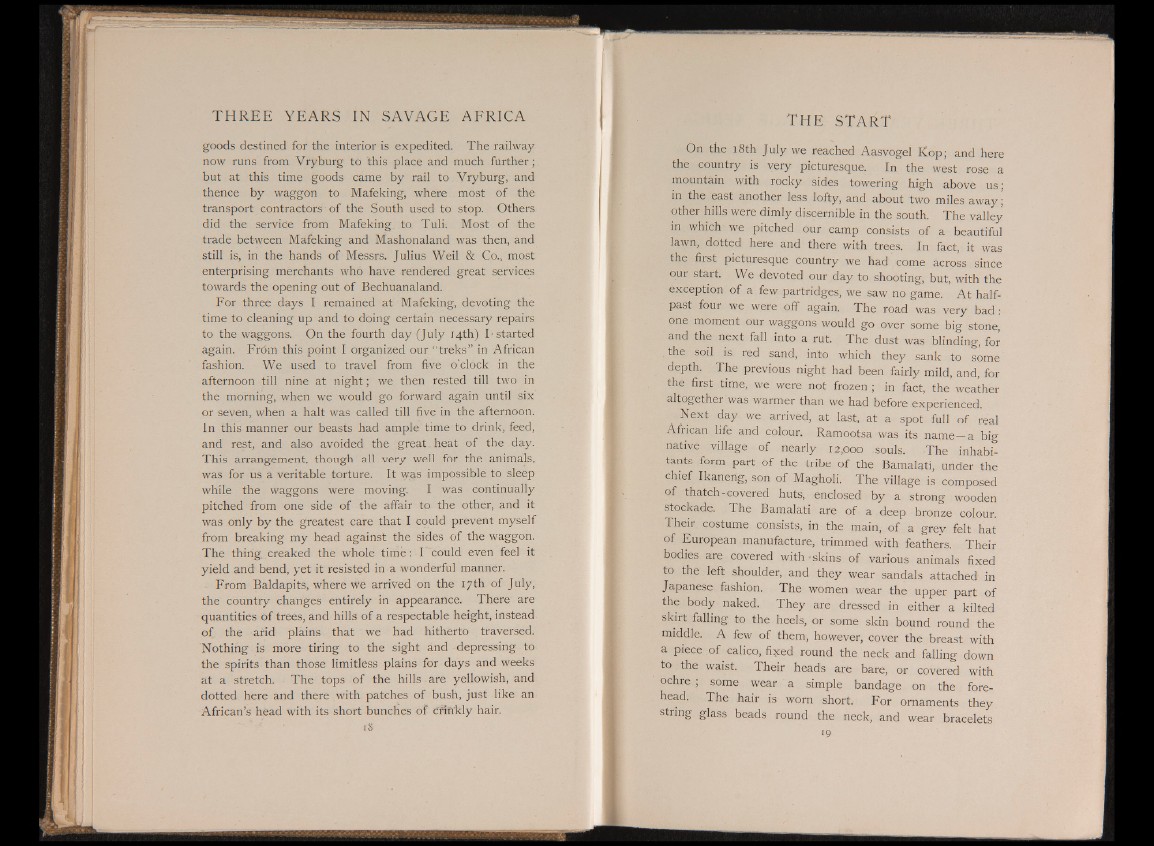
goods destined for the interior is expedited. The railway
now runs from Vryburg to this place and much further;
but at this time goods came by rail to Vryburg, and
thence by waggon to Mafeking, where most of the
transport contractors of the South used to stop. Others
did the service from Mafeking to Tuli. Most of the
trade between Mafeking and Mashonaland was then, and
still is, in the hands of Messrs. Julius Weil & Co., most
enterprising merchants who have rendered great services
towards the opening out of Bechuanaland.
For three days I remained at Mafeking, devoting the
time to cleaning up and to doing certain necessary repairs
to the waggons. On the fourth day (July 14th) I-started
again. From this point I organized our “ treks” in African
fashion. We used to travel from five o'clock in the
afternoon till nine at night; we then rested till two in
the morning, when we would go forward again until six
or seven, when a halt was called till five in the afternoon.
In this manner our beasts had ample time to drink, feed,
and rest, and also avoided the great heat of the day.
This arrangement, though all very well for the animals,
was for us a veritable torture. It was impossible to sleep
while the waggons were moving. I was continually
pitched from one side of the affair to the other, and it
was only by the greatest care that I could prevent myself
from breaking my head against the sides of the waggon.
The thing, creaked the whole time: I could even feel it
yield and bend, yet it resisted in a wonderful manner.
From Baldapits, where we arrived on the 17th of July,
the country changes entirely in appearance. There are
quantities of trees, and hills of a respectable height, instead
of the arid plains that we had hitherto traversed.
Nothing is more tiring to the sight and depressing to
the spirits than those limitless plains for days and weeks
at a stretch. The tops of the hills are yellowish, and
dotted here and there with patches of bush, just like an
African’s head with its short bunches of crinkly hair.
18
On the 18th July we reached Aasvogel Kop; and here
the country is very picturesque. In the west rose a
mountain with rocky sides towering high above us ;
in the east another less lofty, and about two miles away ;
other hills were dimly discernible in the south. The valley
in, which we pitched our camp consists of a beautiful
lawn, dotted here and there with trees. In fact, it was
the first picturesque country we had come across since
our start. We devoted our day to shooting, but, with the
exception of a few partridges, we saw no game. At halfpast
four we were off again. The road was very bad :
one moment our waggons would go over some big stone,
and the next fall into a rut. The dust was blinding, for
the soil is. red sand, into which they sank to some
depth. The previous night had been fairly mild, and, for
the first time, we were not frozen ; in fact, the weather
altogether was warmer than we had before experienced.
Next day we arrived, at last, at a spot full of real
African life and colour. Ramootsa was its name—a big
native village of nearly 12,000 .souls. The inhabitants
form part of the tribe of the Bamalati, under the
chief Ikanerig, son of Magholi. The village is composed
of thatch-covered huts, enclosed by a strong wooden
stockade. The Bamalati are of a deep bronze colour.
Their costume consists, in the main, of a grey felt hat
of European manufacture, trimmed with feathers. Their
bodies are covered with - skins of various animals fixed
to the left shoulder, and they wear sandals attached in
Japanese fashion. The women wear the Upper part of
the body naked. They are dressed in either a kilted
skirt falling to the heels, or some skin bound round the
middle. A few of them, however, cover the breast with
a piece of calico, fixed round the neck and falling down
to the waist. Their heads are bare, or covered with
ochre ; some wear a simple bandage on the forehead.
The hair is worn short. For ornaments they
string glass beads round the neck, and wear bracelets
19